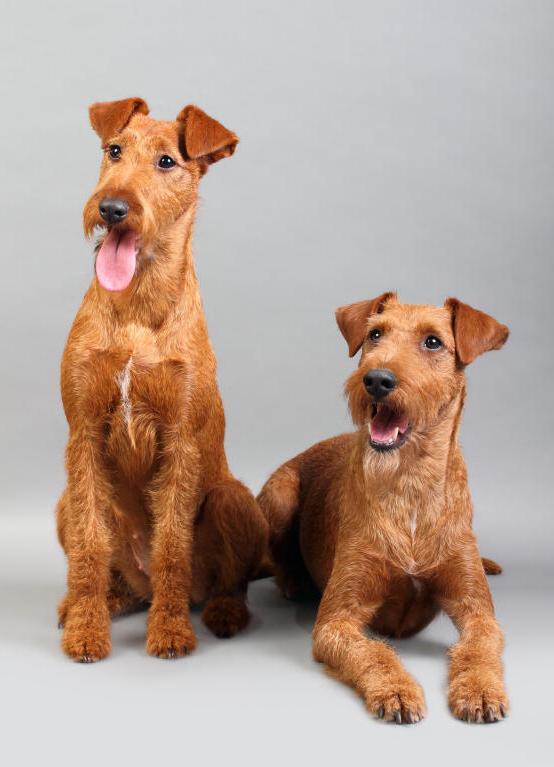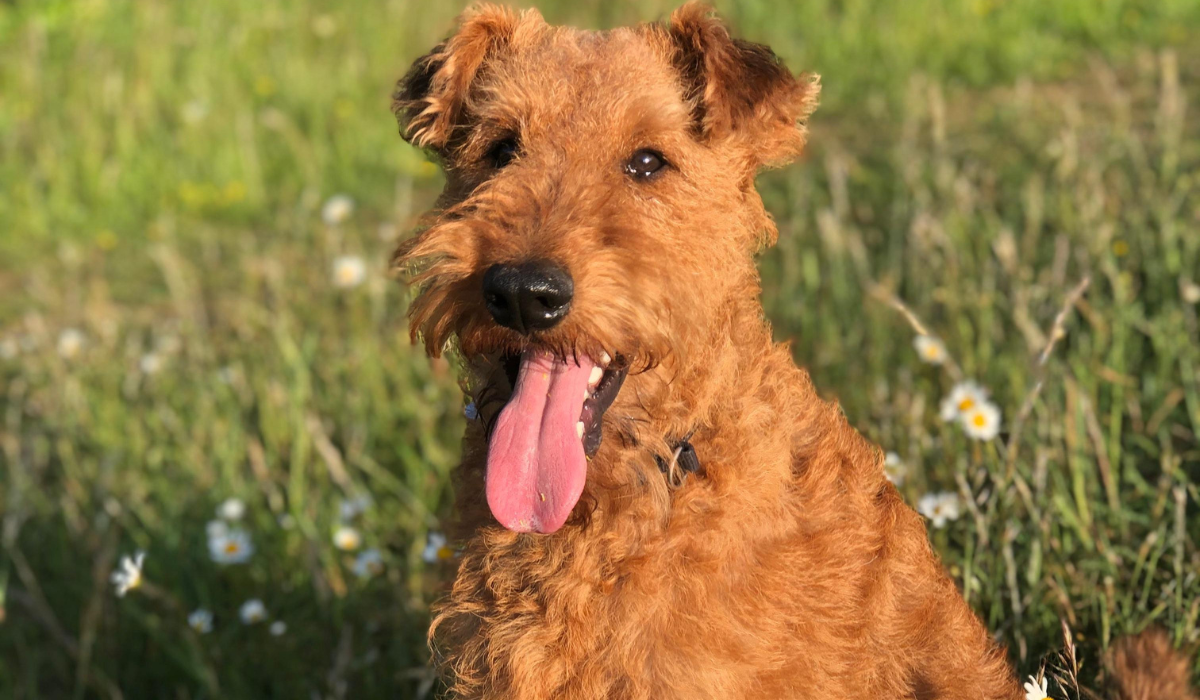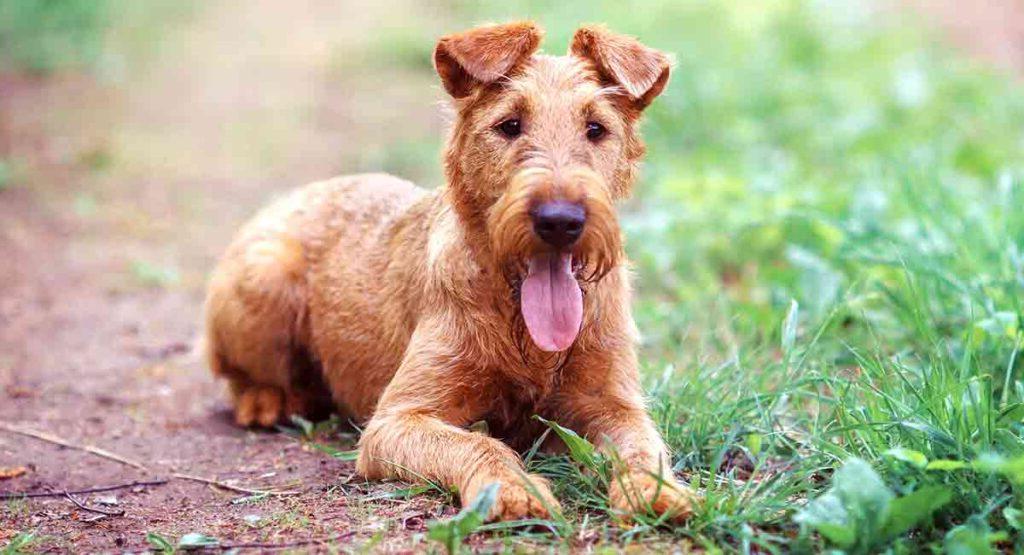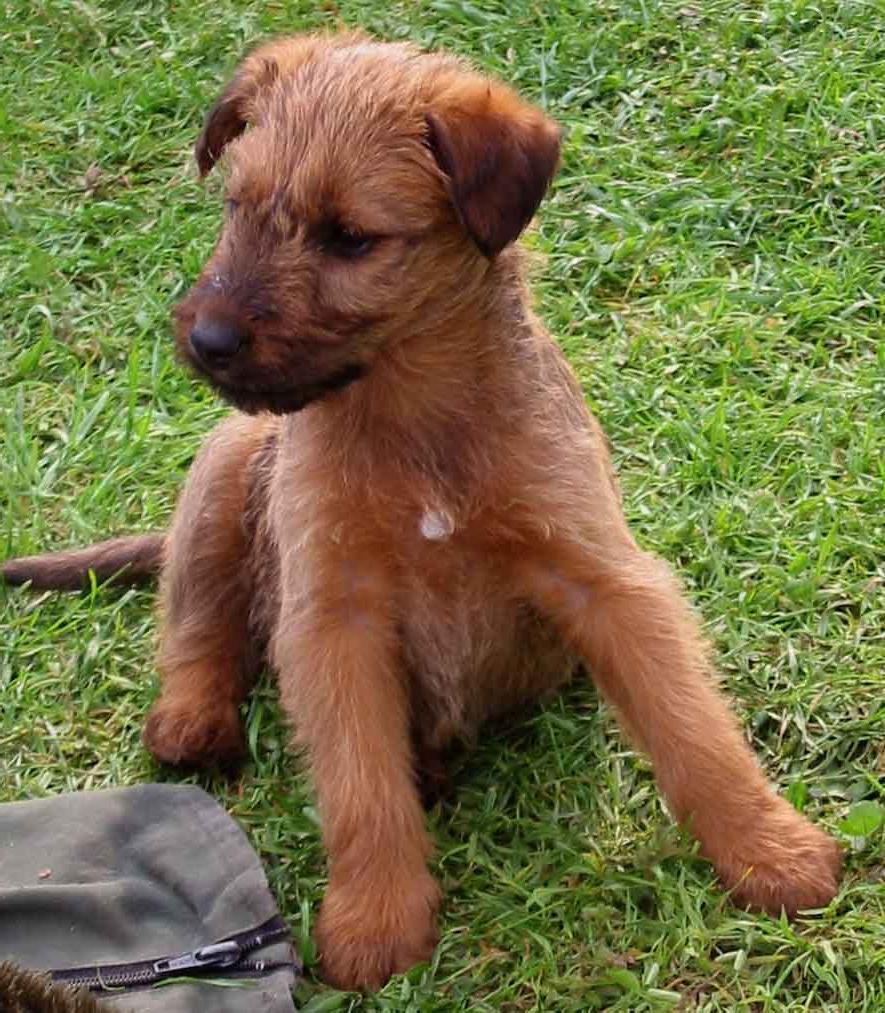- Breed Category: Terrier
- Country of Origin: Ireland
- Average Height: 45-48 cm (18-19 inches)
- Average Weight: 11-12 kg (24-26 pounds)
- Average Life Span: 12-15 years
- Grooming Requirements: Moderate; regular brushing needed
- Exercise Requirements: High; needs daily exercise
- Coat Type: Dense, wiry
- Coat Color Variations: Red, red wheaten, wheaten
- Shedding Level: Low
- Ear Type: V-shaped, folded forward
- Tail Type: Straight, often docked
- Temperament: Bold, spirited, loyal
- Intelligence Level: High
- Barking Tendency: Moderate
- Compatibility with Children: Good with proper socialisation
- Compatibility with Other Pets: May be aggressive towards other dogs
- Training Ease: Moderate; requires consistent training
- Common Health Issues: Hip dysplasia, allergies
- Dietary Needs: High-quality, balanced diet
- Energy Level: High
- Drooling Tendency: Low
- Sensitivity to Weather: Moderate; tolerates cold better
- Overall Maintenance Level: Moderate
- Original Purpose: Hunting, guarding
- Year of Recognition by Kennel Clubs: 1875
- Apartment Friendly: Yes, with sufficient exercise
- Best Suited For: Active families, experienced owners
- Cost of Ownership: Moderate to high
- Unique Traits: Distinctive red coat, fearless nature
- Popularity Rank: Moderately popular
Ever found yourself wondering which dog breed would fit perfectly into your life? Choosing the right one can be a bit of a puzzle. Enter the Irish Terrier, a breed that might just tick all your boxes. Known for their fiery red coat and spirited personality, these dogs are as charming as they are loyal. This article will dive into the world of the Irish Terrier, exploring their unique characteristics, rich history, and how best to care for them.
The Irish Terrier has a storied past, hailing from Ireland as one of the oldest terrier breeds. Originally bred for hunting and guarding, they’ve been companions to humans for centuries. Their history is as vibrant as their personality, making them a fascinating breed to learn about.
Irish Terrier: A Glimpse into Their Heritage and Traits

Early Development of the Breed
The Irish Terrier’s roots run deep in the lush landscapes of Ireland. Initially bred for their agility and tenacity, these dogs were perfect for hunting small game and protecting farms. Their development was shaped by the need for a versatile and resilient companion, capable of handling the rugged Irish terrain.
Role in Irish Culture and Farming
In Irish culture, the Irish Terrier was more than just a working dog. They were a symbol of loyalty and courage, often seen as a farmer’s best friend. Their role extended beyond the fields, becoming cherished family members and guardians of the home.
Key Historical Figures and Events
One notable figure in the breed’s history is Captain Desmond, who played a pivotal role in popularising the Irish Terrier in the late 19th century. The breed gained international recognition, especially after their participation in World War I as messenger dogs, showcasing their intelligence and bravery.
Physical Characteristics
With a striking red coat and a wiry, athletic build, the Irish Terrier is hard to miss. They stand tall and proud, with a keen expression that reflects their spirited nature. Their coat, often described as fiery, is not just for show; it provides protection against the elements, making them well-suited for outdoor adventures.
Appearance and Unique Traits of the Irish Terrier

Distinctive Appearance
The Irish Terrier is a medium-sized dog, typically standing around 45 to 50 centimetres tall at the shoulder. Their coat is a standout feature, with a rich, fiery red hue that catches the eye. It’s dense and wiry, offering protection from harsh weather. This coat isn’t just about looks; it’s practical, too, keeping them comfortable in various climates.
Unique Physical Traits
One of the most striking features of the Irish Terrier is their expressive eyes, which seem to convey a world of emotion and intelligence. Their ears are small and V-shaped, adding to their alert and lively appearance. The tail is usually carried upright, a testament to their confident and spirited nature.
Temperament and Behaviour
Irish Terriers are known for their bold and adventurous spirit. They’re fiercely loyal and protective, making them excellent companions and watchdogs. While they have a strong independent streak, they’re also affectionate and enjoy being part of family activities. Their playful nature means they thrive in active households, where they can engage in plenty of exercise and mental stimulation.
Personality and Suitability of the Irish Terrier

Typical Personality Traits
Irish Terriers are a bundle of courage, loyalty, and intelligence. These dogs are fearless, often taking on challenges with a brave heart. Their loyalty is unmatched, always standing by their family through thick and thin. With a sharp mind, they quickly pick up on new commands and tricks, making them a joy to train.
Suitability as a Family Pet and Working Dog
As family pets, Irish Terriers are a fantastic choice. They bond closely with their human companions and are known for their protective nature. Their history as working dogs means they thrive in environments where they have a job to do, whether it’s guarding the home or participating in dog sports.
Interaction with Children and Other Animals
These terriers are generally good with children, enjoying playtime and adventures. However, their spirited nature means they should be supervised around very young kids. With other animals, early socialisation is key. They can get along well with other pets if introduced properly.
Training and Exercise Needs
Training an Irish Terrier is a rewarding experience due to their intelligence and eagerness to learn. Consistent, positive reinforcement works best. They need plenty of exercise to keep them happy and healthy, so daily walks, play sessions, and mental challenges are essential.
Training, Exercise, and Health of the Irish Terrier
Importance of Early Training and Socialisation
Getting an Irish Terrier off to a good start with early training and socialisation is crucial. These dogs are naturally curious and independent, so introducing them to various environments, people, and other animals early on helps shape a well-rounded adult dog. This foundation is key to managing their spirited nature and ensuring they grow into confident companions.
Recommended Training Techniques
When it comes to training, Irish Terriers respond best to positive reinforcement. Techniques that involve rewards, praise, and consistency work wonders. They thrive on mental challenges, so incorporating fun and engaging activities into their training routine keeps them interested and eager to learn.
Daily Exercise Requirements and Activities They Enjoy
Irish Terriers are energetic and need plenty of daily exercise to stay happy and healthy. A mix of walks, playtime, and interactive games like fetch or agility courses suits them well. They love activities that engage both their body and mind, making them perfect companions for active families.
Health and Lifespan
Generally healthy, Irish Terriers have a lifespan of around 12 to 15 years. Regular vet check-ups, a balanced diet, and plenty of exercise contribute to their longevity. Like all breeds, they can be prone to certain health issues, so staying informed and proactive about their health is important.
Health and Care of the Irish Terrier
Common Health Issues
Irish Terriers are generally robust, but like any breed, they can face certain health challenges. Some may experience skin allergies or hip dysplasia. Regular vet visits are crucial to catch any issues early and keep them in top shape.
Average Lifespan and Health Tips
With proper care, these spirited dogs can live between 12 to 15 years. To ensure they enjoy a long, healthy life, provide a balanced diet, regular exercise, and mental stimulation. Keeping them active not only supports their physical health but also satisfies their curious nature.
Preventative Care Recommendations
Preventative care is key. Regular vaccinations, flea and tick prevention, and dental care are essential. Routine check-ups help monitor their overall health and catch any potential issues early. A proactive approach can make all the difference.
Grooming and Maintenance
Their wiry coat requires regular grooming to keep it looking its best. Brushing a few times a week helps remove loose hair and prevent matting. Occasional hand-stripping maintains their coat’s texture. Regular ear checks and nail trims are also important parts of their grooming routine.
Coat Care and Grooming Routines for the Irish Terrier

Shedding and Seasonal Grooming Tips
The Irish Terrier’s coat is a standout feature, but it does require some attention. While they don’t shed excessively, regular grooming is essential to keep their coat in top condition. During shedding seasons, a bit more effort is needed to manage loose hair. A good brush a few times a week will do wonders, helping to remove dead hair and prevent matting.
Hand-stripping is a technique often recommended for maintaining the coat’s texture. This involves removing dead hair by hand rather than clipping, which helps preserve the coat’s natural look and feel. It’s a bit of a skill, but worth learning or seeking professional help for.
Diet and Nutrition
A balanced diet is crucial for the health and vitality of an Irish Terrier. High-quality dog food that meets their nutritional needs is a must. Look for options rich in protein and healthy fats to support their active lifestyle. Fresh water should always be available, and treats should be given in moderation to prevent weight gain.
Some Irish Terriers may have food sensitivities, so it’s important to monitor their reaction to different foods and consult with a vet if any issues arise. A well-fed Irish Terrier is a happy and energetic companion, ready for any adventure.
Nutritional Needs and Feeding Tips for the Irish Terrier

Nutritional Needs for Optimal Health
Irish Terriers thrive on a diet that supports their energetic lifestyle. High-quality dog food with a good balance of protein, fats, and carbohydrates is essential. Look for foods that list meat as the first ingredient, ensuring they get the protein they need for muscle maintenance and energy.
Foods to Include and Avoid
Include lean meats, fish, and vegetables in their diet. Omega-3 fatty acids from fish oil can help maintain a healthy coat and skin. Avoid foods with artificial additives, excessive fillers, or high sugar content, as these can lead to health issues.
Feeding Schedules and Portion Recommendations
Feed your Irish Terrier twice a day to maintain energy levels and prevent overeating. Portion sizes depend on their age, weight, and activity level, so consult your vet for tailored advice. Always provide fresh water.
Fun Facts and Trivia
Did you know the Irish Terrier is sometimes called the “Daredevil” of the dog world? Their fearless nature and boundless energy make them a standout breed. They were also one of the first terrier breeds to be recognised by the Kennel Club in the late 19th century.
Interesting Tidbits and Famous Irish Terriers

Fascinating Facts About the Breed
Irish Terriers are often referred to as the “Daredevils” of the dog world, thanks to their fearless and adventurous spirit. This nickname is well-earned, as these dogs are known for their boldness and willingness to take on challenges. They were among the first terrier breeds to be recognised by the Kennel Club in the late 19th century, highlighting their long-standing popularity and appeal.
Famous Irish Terriers in Media and History
Irish Terriers have made their mark in both media and history. One of the most famous Irish Terriers was “Jack,” a war hero during World War I. Jack served as a messenger dog, bravely delivering messages across the battlefield. His courage and intelligence were celebrated, earning him a place in history as a symbol of the breed’s bravery.
In the world of cinema, Irish Terriers have also had their moments in the spotlight. They have appeared in various films and TV shows, often cast for their distinctive looks and spirited nature. Their presence on screen only adds to their charm and allure, making them a favourite among dog lovers and filmmakers alike.
Final Thoughts
The Irish Terrier is a bold and loyal companion. With their spirited nature and rich history, they offer both challenges and rewards to their owners. These dogs embody a unique blend of courage, intelligence, and affection, making them ideal for active families and experienced dog lovers. Embracing an Irish Terrier means welcoming a devoted friend into your life, ready for adventures and companionship. Consider this remarkable breed if you’re seeking a fearless and loving addition to your home.
